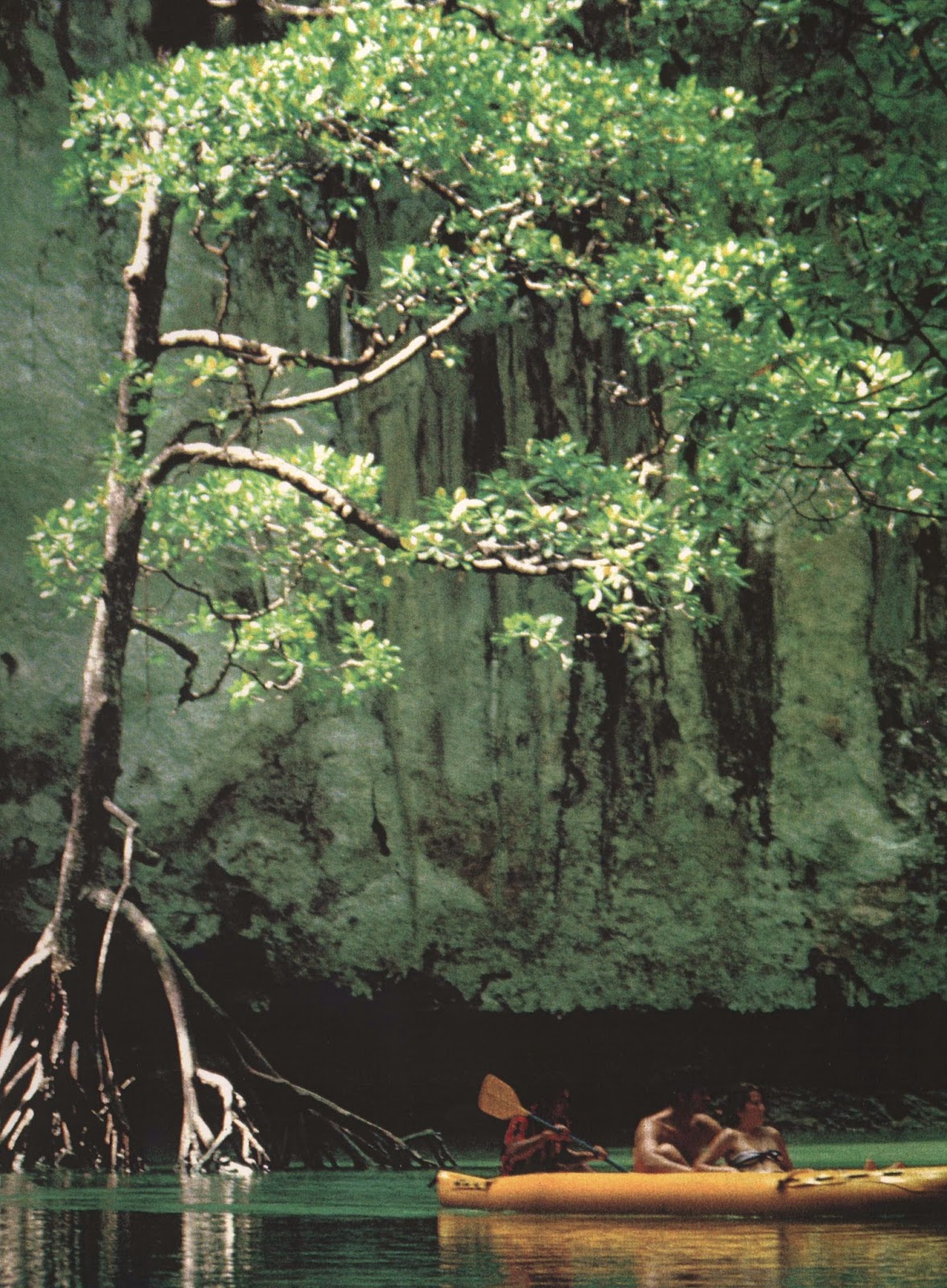The limestone spires of Phang Nga Bay have always exuded an air of mystery. Sea canoeing expeditions open up the very hearts of these islands, where wildlife and nature abound.
Story and pictures by Prisana Nuechterlein
Exploring Phang Nga Bay
“Look up, but keep your mouth shut,” Joe whispers. I look up at the dark cave ceiling, trying to see the bats I hear squeaking overhead. They flit and flutter in the dim beam of my flashlight under sparkling stalactites that drape down the cave wall like a glistening ice curtain. Then suddenly, it is pitch black. The flashlight has gone dead and we bump up against the cave wall in the blinding darkness.
“Don’t worry,” Joe says reassuringly, “I know the way out.”
Joe, a young Thai sea canoe guide, has taken hundreds of guests into Bat Cave over the past two years. They have all survived, despite having “Crazy Joe” as their guide. Like most Thais, Joe loves drama. Earlier in the day, we had nearly paddled over a giant crocodile. The ‘giant crocodile’- a viciously jagged rock, was yet another creation of Joe’s vivid imagination. A short time later we encountered a ‘wild elephant’ – a limestone formation that actually did look like an elephant’s head.
Escaping from Bat Cave
After a few moments of drifting in total darkness, I begin
to feel like a bat. The pungent odor of bat dung envelopes us. Joe turns the
canoe and we hit another cave wall. He grabs the flashlight, fumbles with it
until it comes back to life.
“Watch your head,” he warns.
I duck just in time to miss a low hanging stalactite. Slipping underneath a rocky archway, we suddenly emerge into the blinding sunlight of Bat Hong.
The dramatic limestone islands of Phang Nga Bay are regarded as one of Thailand’s most mystical and stunning seascapes. A compelling geological masterpiece; the colossal spires are world famous for their collection of what once was described as “secret” hongs – hearts of islands, containing natural sanctuaries of unsurpassed beauty.
Lying only an hour away from Phuket, the hongs (literally meaning “room” in Thai) are hidden tidal lagoons, completely enclosed by sheer limestone cliff walls. The only way to access these amazing hongs is through sea caves – some so narrow they resemble rocky cocoons.
We glide over the calm water inside Bat Hong, absorbing the primeval world around us in quiet meditation. The hong buzzes with swirling insect noises and melodic bird songs. Towering mangrove trees soar above us covering the jungle-fringed cliffs. Joe points to my left. A large owl stares down at us. Mudskippers jump across giant mangrove roots. Tiny silver fish dart under our canoe. We retreat to a shady corner and sit in silence absorbing the marvelous view around us. Joe continues paddling, taking us through a narrow passage into smaller hong. He taps my shoulder and points up into the treetops. I see a brown blur and then spot a group of monkeys sitting atop the branches.
Back on board the support boat, the delicious aroma of lunch greets us. Boom, our talented chef, has prepared a feast of spicy prawns, lemongrass-coconut milk and shrimp soup, grilled fish, ginger chicken, mixed vegetables and fried rice. We are in culinary heaven, practically licking our plates clean.
John "Caveman" Gray
Sea canoe trips to Phang Nga Bay first began in 1989, after conservationist John “Caveman” Gray, also known as "Ling Yai" (meaning big monkey in Thai), discovered several sea cave windows leading into the hongs. From the vantage point of his trusty sea canoe, Gray observed the tidal movements at various caves and diligently recorded the intervals between their closing and opening. After months of exploration and observation, his findings provided him with the tidal knowledge necessary to lead sea canoe excursions.
Today, there are numerous sea canoe companies competing for space in the once pristine hongs. Occasionally, there is even a “traffic jam” of canoes waiting to enter the caves. It is a far cry from the secret world Gray first shared with his truly fortunate guests, but still well worth the trip to Phang Nga Bay.
We head out to Mangrove Hong and enter a sea cave scarcely large enough for our sea canoe. The tide is high now, making the “window” or access way inside the karst monoliths, nearly impossible. “Please lie back and keep your arms and legs inside the canoe,” Joe warns. The jagged, oyster encrusted opening passes only a meter above my nose. I imagine what Caveman must have felt upon entering the cave for the very first time, not knowing where the dark claustrophobic cave would lead him. For us, it is a thrilling adventure, especially having an expert like Joe to guide us.
“Watch your head,” he warns.
I duck just in time to miss a low hanging stalactite. Slipping underneath a rocky archway, we suddenly emerge into the blinding sunlight of Bat Hong.
The dramatic limestone islands of Phang Nga Bay are regarded as one of Thailand’s most mystical and stunning seascapes. A compelling geological masterpiece; the colossal spires are world famous for their collection of what once was described as “secret” hongs – hearts of islands, containing natural sanctuaries of unsurpassed beauty.
Lying only an hour away from Phuket, the hongs (literally meaning “room” in Thai) are hidden tidal lagoons, completely enclosed by sheer limestone cliff walls. The only way to access these amazing hongs is through sea caves – some so narrow they resemble rocky cocoons.
We glide over the calm water inside Bat Hong, absorbing the primeval world around us in quiet meditation. The hong buzzes with swirling insect noises and melodic bird songs. Towering mangrove trees soar above us covering the jungle-fringed cliffs. Joe points to my left. A large owl stares down at us. Mudskippers jump across giant mangrove roots. Tiny silver fish dart under our canoe. We retreat to a shady corner and sit in silence absorbing the marvelous view around us. Joe continues paddling, taking us through a narrow passage into smaller hong. He taps my shoulder and points up into the treetops. I see a brown blur and then spot a group of monkeys sitting atop the branches.
Back on board the support boat, the delicious aroma of lunch greets us. Boom, our talented chef, has prepared a feast of spicy prawns, lemongrass-coconut milk and shrimp soup, grilled fish, ginger chicken, mixed vegetables and fried rice. We are in culinary heaven, practically licking our plates clean.
John "Caveman" Gray
Sea canoe trips to Phang Nga Bay first began in 1989, after conservationist John “Caveman” Gray, also known as "Ling Yai" (meaning big monkey in Thai), discovered several sea cave windows leading into the hongs. From the vantage point of his trusty sea canoe, Gray observed the tidal movements at various caves and diligently recorded the intervals between their closing and opening. After months of exploration and observation, his findings provided him with the tidal knowledge necessary to lead sea canoe excursions.
Today, there are numerous sea canoe companies competing for space in the once pristine hongs. Occasionally, there is even a “traffic jam” of canoes waiting to enter the caves. It is a far cry from the secret world Gray first shared with his truly fortunate guests, but still well worth the trip to Phang Nga Bay.
We head out to Mangrove Hong and enter a sea cave scarcely large enough for our sea canoe. The tide is high now, making the “window” or access way inside the karst monoliths, nearly impossible. “Please lie back and keep your arms and legs inside the canoe,” Joe warns. The jagged, oyster encrusted opening passes only a meter above my nose. I imagine what Caveman must have felt upon entering the cave for the very first time, not knowing where the dark claustrophobic cave would lead him. For us, it is a thrilling adventure, especially having an expert like Joe to guide us.
Back out in the open sea, we circumnavigate Koh Hong. The
sound of the ocean echoes eerily, rocking back and forth underneath the
limestone overhangs. Joe spots a huge sea lizard climbing out of the slapping
water onto a rocky ledge. The lizard freezes for a moment, gives us a curious
glance, then scrambles away into the water.
After a brilliant day of hong exploration, we return to Phuket quenched with a wondrous feeling of having seen the best that Nature could create.
"This place is perfect nature,” Joe remarks.
Perfect in every way.

After a brilliant day of hong exploration, we return to Phuket quenched with a wondrous feeling of having seen the best that Nature could create.
"This place is perfect nature,” Joe remarks.
Perfect in every way.

Recommended Sea Canoe Company
John Gray Sea Canoe Co., Ltd.
124 Soi 1 Yaowarat Rd., Taladyai, Muang, Phuket 83000, Thailand
Tel. (66-76) 254505-7 | Fax: (66-76) 226077
E-mail: info.web@johngray-seacanoe.com
Website: http://www.johngray-seacanoe.com/





No comments:
Post a Comment